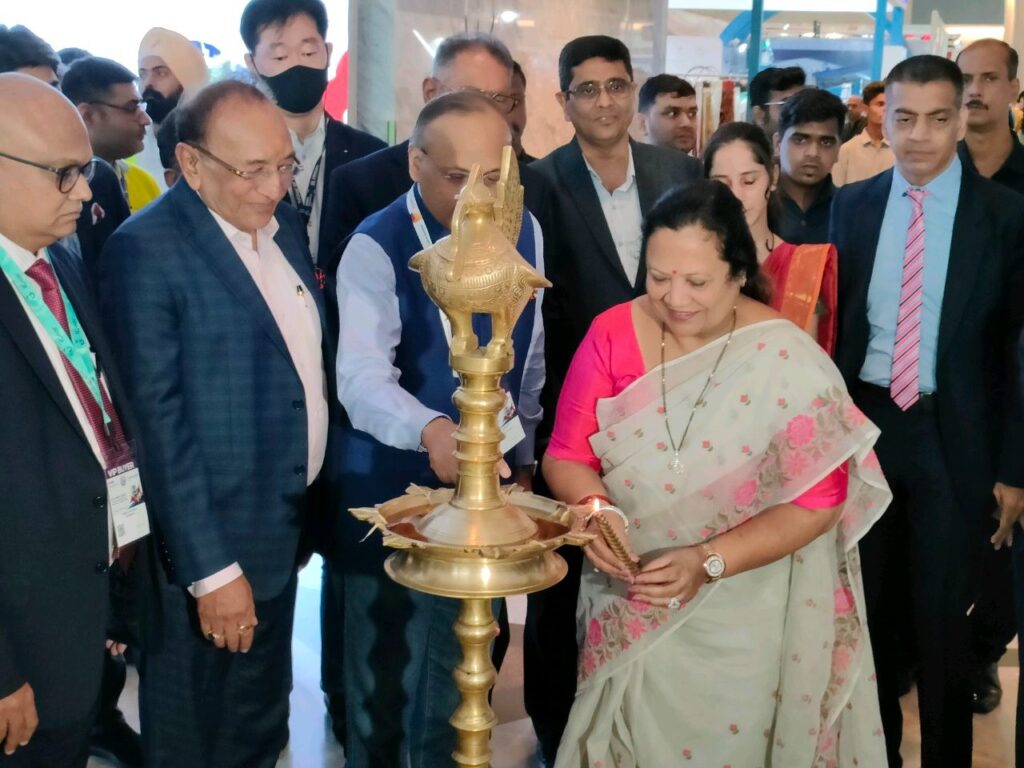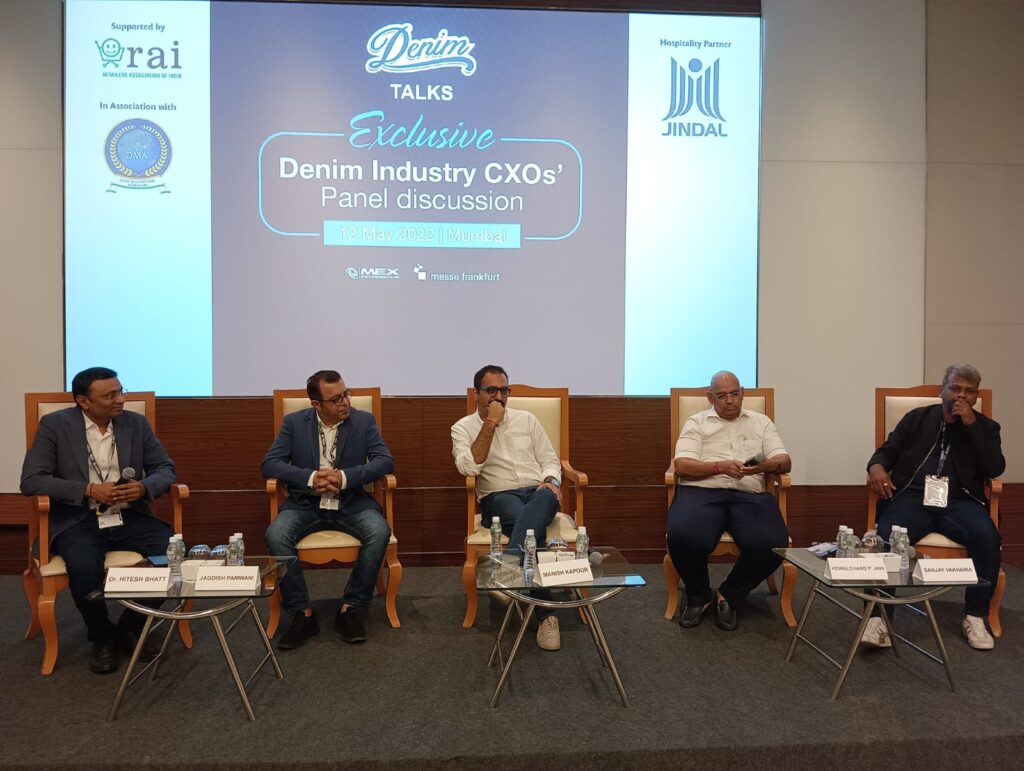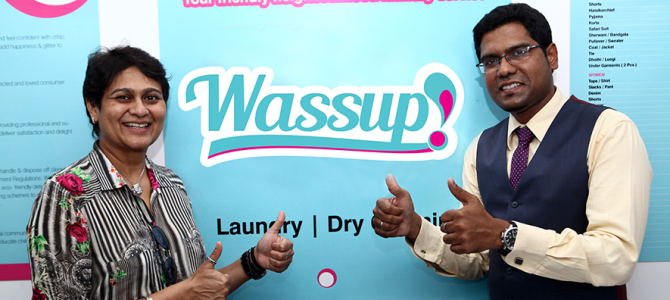
The Mumbai edition of Gartex Texprocess India 2022 opened yesterday with more than 100 exhibitors and over 250 brands on the show floor. The mega expo has Denim Show, Fabric & Trims Show and Screen Print India under its umbrella. Retailers Association of India was a key supporting partner for the Denim Show.
Commencing the three-day proceeding, the trade fair was inaugurated by eminent figures from Ministry, associations and industry leaders, including:
• Smt Darshana Jardosh, Hon’ble Union Minister of State for Textiles & Railways, Government of India
• Mr Sharad Jaipuria, CMD, Ginni International Ltd & President, Denim Manufacturers Association
• Mr Jang Gyoo Lim, Director, Hysoung India Pvt Ltd (Creora)
• Shri Yamunadutt Agarwal, Chairman, Jindal Worldwide Ltd
• Ms Himani Gulati, Director, MEX Exhibitions
• Mr Stephan Buurma, Member of the Board of Management, Messe Frankfurt Group
• Mr Raj Manek, Executive Director and Board Member, Messe Frankfurt Asia Holdings Ltd
• Mr Gaurav Juneja, Director, MEX Exhibitions

The Denim Talks series was held as part of the Gartex Texprocess India’s knowledge forum which included several insightful CXO panel discussions. The first in the series was a panel discussion in collaboration with the Retailers Association of India on ‘Denim Dreams: Roadmap to Building a Sustainable, Profitable Future’. Moderated by Dr Hitesh Bhatt, Director-Marketing & Communication at RAI, the panel discussion had leaders of some of the country’s leading denim brands deliberating on the challenges, opportunities sustainability and growth of the denim business. The panellists included Sanjay Vakharia, Founder & CEO, Spykar Lifestyles; Kewalchand P Jain, Chairman & MD, Kewal Kiran Clothing (Killer); Manish Kapoor, MD & CEO, Pepe jeans; and Jagdish Pamwani, VP-Production & Sourcing, Being Human Clothing.
Key Takeaways from the discussion are as follows:
1. There is no dearth of business for denim players in India
2. The entire denim ecosystem is getting environmentally conscious
3. Denim industry has the potential to grow 25% CAGR in the next 4-5 years
4. Innovation is the name of the game
5. Denim cannot be sold by advertising. The product itself needs to appeal to the consumer.
The Gartex Texprocess India 2022 was organised by MEX Exhibitions Pvt. Ltd. and Messe Frankfurt India.
]]>In the last one and a half year, the retail industry has undergone tremendous change at various levels—operations, customer behaviour, supply chain and payments being some of the key areas affected. From operations to strategy, organisations have had to face a lot of disruption. Brands from different categories handled the challenges in their own ways. Insights and key takeaways from some leading brands on their journey towards becoming Agile, Customer-Centric & Resilient…
What is changing in retail
- Shorter planning to execution journey
- Shorter Mind to Market, time to market cycles
- Flexible, variable arrangements with partners, employees
- Everything as a service. Products and Services got commoditized.
- Local players are becoming regional, regional players are becoming national.
- Contactless-experience in offline and online activities, including the logistics and supply chain handling of a product.
- Contactless and online payments witnessing a strong momentum as against cash transactions.
- Blurring of the boundary between online and offline.
- Acceleration of all variants of shopping including stores on wheels, store to door, click and collect, and the omni-channel avatars.
- Social media causing obsolescence cycles to be low.
- Technology and tools becoming democratized, modularized and available.
- No more one way of doing business.
- Deeper penetration of e-commerce, digital payments including in tier 2, tier 3 towns.
- Emergence of UPI as a main instrument for digital payments.
- Reducing non-value add in everything a business does.
- New metrics for measurement as word of mouth gives way to social media. NPS not an accurate measure of brand popularity. The equation one detractor will take away one promotor giving way to one detractor will take away several promotors.
- Anything and everything that you will design will be far more input driven and consumer-centric.
- Live commerce becoming mainstream. Interlinking of live commerce and content.
Changes in consumer behaviour
- Health, wellness and comfort top of mind for customers.
- Shift in focus from looking good for others to looking good for oneself.
- Shift from shopping at local stores to branded stores, especially in the tier 2 cities.
- Preference to chat over video / WhatsApp with brands before making purchase decisions in Tier-2, Tier 3 cities.
- Brand loyalties getting fickle, forcing brands to make changes required to become highly customer-centric by investing in technologies and insights that help provide best-in class customer journeys.
- Couch-based consumption of products, services or content becoming norm. OTT taking off in a big way, resulting in brands spending more on digital / more nuanced marketing with mass personalisation.
- Big shift towards solidarity spending with more and more people wanting to be a part of a cause they believe in.
- Change in what propels consumers to shop at a brand whether online, offline.
Hyper-personalisation
- Hyper-personalisation becoming ever more important.
- Increased use of data to augment offline experience.
- Use of visual AI that mimic a salesperson’s behaviour to read customer preferences.
- Hyper personalisation technologies becoming more affordable and available off the shelf.
In Conclusion
Madhav Nishtala, Director Retail, Industry & Customer Advisory, SAP India
- The whole approach is about connecting customer intimacy back to business operations.
- Tech today is the core glue that binds businesses together and has been a catalyst for transformation.
- With SAP solutions at helm, retailers can offer their consumers the products and personalized shopping experiences they want every time.
Strategic priorities
- Digitising decision-making
- Introducing endless aisle at stores.
- Automating feedback
- Hyper-personalisation
- Agility in business, reducing planning to execution time
 Amit Modak, CEO, P.N Gadgil & Sons Ltd.
Amit Modak, CEO, P.N Gadgil & Sons Ltd.
- Capacity optimisation
- Investing in inventory visibility
- Educating customers on advantages of shopping with compliant brands
 Dharmarajan K, Chief product Officer, Tata CLIQ
Dharmarajan K, Chief product Officer, Tata CLIQ
- Scaling faster
- Building new lines of businesses
- Moving to a more agile micro-services-based structure to iterate faster and faster release of features for consumers
- Increased focus on security, compliance and privacy
- Hiring best in class tech talent.
 Lavanya Nalli, Vice Chairperson, Nalli Group
Lavanya Nalli, Vice Chairperson, Nalli Group
- Making prudent investments as leaders in technology.
- Achieving true hyper-personalisation
- Doing everything to serve consumers better and follow good business practices in terms of keeping costs as low as possible, reducing waste and increasing efficiencies. All this requires you to have a very strong robust tech-enabled backend and front-end.
 Rajgopal Nayak, CTO, Metro Brands Ltd.
Rajgopal Nayak, CTO, Metro Brands Ltd.
- Making business more relevant to consumers
- Being open to new technology
Being ready to constantly embrace change and do whatever it takes to achieve goal number one.
]]>The Government of India has made items such as cereals and food grain GST-free and imposed a 5 per cent levy on branded food grain and cereals. This seems to imply that items that are packaged are to be taxed while those that are not packaged would not be taxed. The perception seems to be that packed items are not good for consumers and companies selling the packed items are making more money.
The truth is far from it. Packaged commodities are essential to the wellbeing of this country. Companies that package goods take responsibility for what they sell. This creates guarantees for customers. This is completely missing in the case of the commodities that are sold in loose. The Food Safety and Standards Authority of India (FSSAI) encourages proper packaging and fortification in the country. In this scenario, taxing of branded packaged products is not only unfair to the manufacturer/packer, but also to consumers as it takes away any incentive to provide information and assurance about healthy wholesome commodities to consumers.
This move to tax packaged commodities may take Indian market and the consumer movement several decades backwards and will mark the beginning of the movement from packaged commodities to loose, unpacked commodities and put consumers at a great risk.
Packaging is critical for transportation, preservation, quality, shelf life, protection against the elements and against adulteration etc. It is observed that in case of commodities such as milk, water, edible oil, honey, grains, tea, atta, sugar that are sold in loose form, the adulteration is as much as 80-90%. Any adulteration in packaged commodities is traceable since the name of the packer/manufacturer is specified.
India has had adulteration as a big issue and when people take additional step towards packaging, keeping it in hygienic conditions, giving it to customers, putting their name on it, they are giving them a guarantee.
We believe that packaging and branding is an additional service and the Government should incentivise this rather than disincentivise.
– by Gautam Jain
Gautam Jain is Director – Advocacy and Chief Financial Officer at Retailers Association of India. He is a Chartered Accountant by qualification with wide industry knowledge and experience.
]]> Industries can stay the same for decades until a disruption comes along that changes the face of that business forever. In India, the market for laundry was mostly unorganised with traditional dhobiwalas washing clothes like they’d always done and ironing them with a coal iron. It is here that Balachandar R from Chennai saw an opportunity and started a company, Wassup Laundry that offers end-to-end laundry service for consumers and B2B clients. Completely modernising how laundry is done, Wassup uses treated water and ensures that each garment is washed as per the requirements prescribed in the label.
Industries can stay the same for decades until a disruption comes along that changes the face of that business forever. In India, the market for laundry was mostly unorganised with traditional dhobiwalas washing clothes like they’d always done and ironing them with a coal iron. It is here that Balachandar R from Chennai saw an opportunity and started a company, Wassup Laundry that offers end-to-end laundry service for consumers and B2B clients. Completely modernising how laundry is done, Wassup uses treated water and ensures that each garment is washed as per the requirements prescribed in the label.
Currently present in 7 large cities including New Delhi, Mumbai, and Chennai, Wassup plans to expand further before a planned IPO in 2019. Taj Vivanta, the Radisson, the Indian Navy are some of its more illustrious clients in the B2B space but the enterprise’s real value lies in how it makes life simpler for couples who are working or people who just don’t have time for the mundane task of laundry. Wassup Laundry was second runners up at the Retail Startup Awards 2017 held this year in Mumbai, & they have been in the news for acquiring a Mumbai-based home laundry service in an equity swap.
In conversation with GlobalLinker (GL) Balachandar R (BR) shares the story of Wassup Laundry and his plans for the company.
GL: Tell us about your business.
BR: After spending over 15 years in the retail industry with various companies such as Hidesign, Tata International, I wanted to start something unique of my own. While doing background research on potential business ideas, I noticed a huge gap in the organised laundry segment. I then decided to work on creating a national laundry brand which brings convenience & quality service to the doorstep. Laundry is an essential necessity of daily urban life, and residents, especially in metro cities, find it challenging to take care of this themselves. There are hardly any professional companies present in this sector. Taking this use case for the urban market, I developed a business model providing laundry service delivered to the doorstep. I held discussions with Durga Das, who was first an investor in our venture, and later came on board as co-founder who also helped me fine-tune my business plan. We launched Wassup in 2011 as an integrated omni-channel player with a processing facility & retail shops where people can drop off their clothes for washing and a mobile app through which an order can be placed along with a 24-hour toll free helpline number. Customers can avail laundry, dry cleaning & shoe/bag refurbishment services through our platform.
GL: What are the challenges you have faced in establishing your business?
BR: Managing unit economics in the laundry segment is extremely hard as there is a logistics component attached to it. Apart from that, the industry backend for laundry services is quite underdeveloped. Aggregating the service via outsourcing partners is very difficult. It is also difficult to attract skilled labour and bring the consistency to ensure customer satisfaction. We decided to set up our own backend facility to keep a check on quality. Manual involvement is involved at various stages in the service process, and to ensure a higher accountability of procedures and quality issues, we built an in-house laundry management software.
GL: What is the USP of your business?
BR: Wassup is India’s only omni-channel player in the laundry segment. It operates via multiple channels such as a website, mobile app (Play Store & Apple store) & a toll free helpline number through which customers can place pickup requests for their laundry right from their doorstep. Apart from these channels, we also have collection stores where customers can physically drop off & collect their clothes after laundering. We are a full stack model with backend processing facilities in each city along with a front end technology platform for customers and a POS system provided at each store for easy order tracking and management.
GL: What are some of the milestones of your business?
BR: Founded in 2011 in Chennai, Wassup has expanded its user base across 7 cities in the form of franchisee stores & collection points and at current has around 40 stores across India. We have serviced over 3 lakh clients and washed over 50 million pieces in the last 5 years. We have a mix of B2C customers & corporate B2B customers we are also servicing hotels, hospitals, spas, salons etc. Currently, we have expanded to 7 major metro cities in India, and are processing around 75,000 pieces of garments on a daily basis at our facilities. We are targeting to be a Rs 500 crore company in the next 4 years.
This year we were voted the third best retail startup at the Retail Startup Awards at the Retail Leadership Summit in Mumbai presented by the Future Group.
GL: What role do you feel GlobalLinker plays in connecting and assisting SMEs?
BR: GlobalLinker’s large network of entrepreneurs, corporates & investors across the globe can help us expand our knowledge base and also seek opportunities beyond our current geography. We feel there is a lot to learn through the experience and problems faced by entrepreneurs across various verticals of SME businesses and help us build a solid business strategy for the global market.
GL: What is your big business dream?
BR: I want to grow Wassup into a company with a Rs 500 crore turnover by the end of 2020 and launch the first IPO in the laundry sector. We want to diversify the brand into multiple affiliate products & services which are co-related to our primary business offering. We believe with a target market of over Rs 2 lakh crores, we want to go public by the year 2019 through an initial public offering (IPO).
GL: What is your message to aspiring entrepreneurs?
BR: My message to aspiring entrepreneurs is that, first, start a business for the right reason. Second, focus on value creation and valuation. Third, persevere with your passion – it takes many sleepless nights to become an overnight success.
]]>New-age technology has made retail functions even more capable of fulfilling even the most detailed shopping need – be it the choice of selecting 1000 brands at the swipe of your fingertip, or getting your favorite accessory delivered to your doorstep through the click of a button.
As Abhishekh Ganguly, MD, Puma India notes, “Consumers have unlimited resources in discovering new products by the second, making decisions of what to buy, and then exploring the best avenue to source the product. More often than not, all of this happens through the virtual world. The internet as the premier source of information feeds consumers with every last detail they desire, and through this, they can make an informed purchase decision — not only on the kind of product that they must buy, but also whether to buy it online, or at a physical store! That’s the unhinged edge that consumers have these days when it comes to shopping.”
With the plethora of options available to consumers to fulfil their shopping desires, both online and offline, experts note that the key to keeping customer loyalty is by delivering a seamless retail experience.
Nihir Parikh, Chief Business Officer, Nykaa.com notes, “It’s about bringing the online experience offline, and vice-versa. For the physical store to be able to offer kind of scale of choice in products that the online world offers, And for the online store to be able to offer the kind of personalized shopping experience that the physical world does. That, I believe is the key to delivering a seamless experience”, as Harsh Shah adds, “And good content, timely education/advice (given to customers and genuineness in the kind of services and products offered are the 3 pegs to achieving this. Educate the consumer holistically, continually influence them via online means, and allow them the convenience of choice to purchase those very products online or offline.”
To this, the key importance of maintaining the sanctity of the customer’s personal space and choice comes into play, as Abheek Singhi, Senior Partner + Director, Boston Consulting Group notes, “The experience that retailers offer must be able to walk the fine line between advisory support and infringing on privacy. Retailers must be able to offer advisory support through smart predictions and various other such means using technology, yet be cautious enough to ensure that consumers feel free to choose and purchase the products they like, as observed in physical shopping.”
Keeping up with the customer in both online and offline worlds was conclusively agreed upon by experts as the key to delivering an optimal seamless experience. As Gaurav Mahajan, President, Apparel – Raymond Ltd highlights, “The consumer now-a-days moves from the online space to the offline space in less than a blink of the eye. All thanks to the smartphone revolution! The key for all of us here is to be able to traversing the physical and digital spaces in sync with the consumer. We must be able to reach and access the consumer across channels – digital and physical, and finally be able to transact with the consumer efficiently, irrespective of the platform. Once you are able to understand how the customer lives inside and outside the digital realm, it will give you clarity on how to align your online and offline stores to deliver the best shopping experience, and ensure that the customer chooses you over the competition, and comes back to shop with you!”
As Vikrant Yadav, Head of Business – India, Grey Orange concludes, “The secret to converting a single channel customer into a multi-channel customer is by allowing the customer to feel and believe that they are in complete control of the shopping process, and by affording them with the options and convenience, the best of both worlds in both worlds, be it online or offline.”
Based on the Retail Leadership Summit 2017 panel discussion ‘The Secret to delivering a Seamless Experience’. Moderator: Lee. S. Gill, Group VP, Global Retail Industry Strategy, JDA Software; Panelists: Abhishekh Ganguly, MD, Puma India; Abheek Singhi, Senior Partner + Director, Boston Consulting Group; Gaurav Mahajan, President, Apparel – Raymond Ltd; Harsh Shah, Co-Founder, Fynd; Nihir Parikh, Chief Business Officer, Nykaa.com; Vikrant Yadav, Head of Business – India, Grey Orange.
]]>

